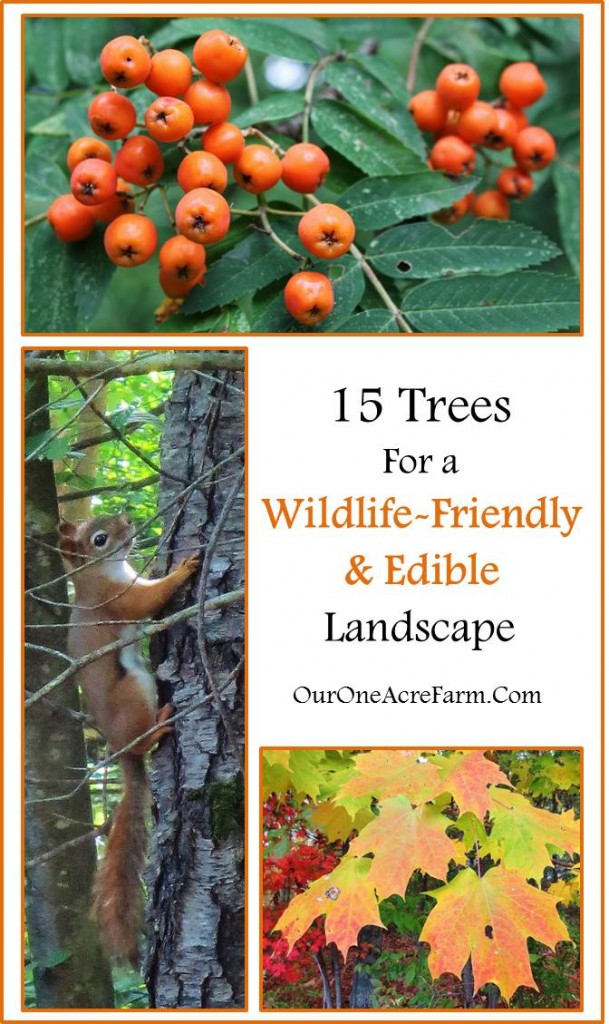 Creating a wildlife-friendly, edible backyard had been a dream of mine for years. When we saw this property 20 years ago, I knew immediately that this was the perfect place for it. The 1+ acre of land had the house within it, and trees and shrubs growing wild around the property boundary. The rest was open, without so much as a shrub at the front door.
Creating a wildlife-friendly, edible backyard had been a dream of mine for years. When we saw this property 20 years ago, I knew immediately that this was the perfect place for it. The 1+ acre of land had the house within it, and trees and shrubs growing wild around the property boundary. The rest was open, without so much as a shrub at the front door.
Over the first few years, we added some of the trees on this list to the oaks, maples, birches, hickories, pines, cherries, aspens, and crabapples already on the periphery. We also added plenty of shrubs, a flower garden, and a vegetable garden. Then the magic began to happen. The yard came alive with wildlife, and yielded fresh, organic food for us!
Basic considerations
- Choose trees native to your area, because they fulfill the needs of native animals better than non-native plants.
- Consider soil type, moisture, and climate preferred by each tree.
- Think beyond berries and birds, and consider nectar, leaves, buds, and twigs as food for insects and mammals, as well as for birds.
Books which I have found indispensable in developing my edible wildlife habitat
Please note that this blog is not meant to be THE definitive sources on edible wild plants. Always consult several authoritative sources before consuming any wild plant! Eat only when you are certain of the plant’s identity.
15 Trees for a Wildlife-Friendly, Edible Landscape
All of the trees here provide excellent food, cover, and/or nesting sites for wildlife, as well as food for people.
Small trees
These are trees which typically grow to less than 50 feet in height, and which tend to fruit at a younger age. They are good choices for planting if you want to harvest their fruits within your own lifetime!
1. American Mountain Ash, Sorbus americana
Almost 20 years ago, when we were planning an edible and wildlife friendly landscape for our yard, I had American Mountain Ash on the list. Unfortunately, I allowed myself to be talked out of it. I was told that the native tree tends to be short-lived. So instead, I chose the European mountain ash. If I had fully understood how important native plants are to our native animals, I never would have made that decision.
Wildlife value
- At least 25 bird species are known to eat them, and turkey, pileated woodpecker, eastern kingbird, gray catbird, eastern bluebird, and red-eyed vireo are quite partial to them. Bears, fishers, and martens also like the berries.
- The flowers are pollinated by a variety of native insects
- Host plant for the larvae of tiger swallowtail butterflies
Edible berries
- Used for jellies, jam, and wine, and often cooked with meat
- High in vitamin C, vitamin A, and iron
Other notes
- Often dies by the age of 30.
- Can live for 70 years in optimal conditions (cool, humid climate and rich soil).
2. American Persimmon, Diospyros virginiana
This is not a tree I have personal experience with, because it ranges further south. But it’s valuable for the edible and wildlife friendly garden, and seedlings fruit within 6 years after planting.
Wildlife value
- Fruit preferred by waxwings, mockingbirds, catbirds, robins, turkeys, woodpeckers, foxes, bears, raccoons, skunks, rodents, and others.
- Flowers are of special valuable to honeybees, and it is a host plant for larvae of the luna moth.
- Deer browse it.
Edible fruit
- For jams and jellies.
- Seedlings may bear fruit within 6-10 yrs after planting
3. Cherry, Prunus species
Native cherries are excellent choices for the edible and wildlife friendly garden. Black cherry, Prunus serotina, is very common along one of my walking routes, and every year I see Baltimore orioles nesting in it. It’s on the borderline between “small” and “large” since it sometimes reaches 60 feet. But its relatives, pin cherry and chokecherry are much smaller, and offer similar landscape value.
Wildlife value
- Host plant for over 200 species of butterflies and moths, including tiger swallowtails, coral hairstreak, striped hairstreak, red-spotted purple, cecropia, promethea moth, and hummingbird clearwing moth.
- The berries are a favorite of at least 50 species of birds, including various woodpeckers, tanagers, orioles, finches, sparrows, and grouse.
- Pollinating bees, flies, and beetles visit it for pollen and nectar.
- Mammals seem to like the berries as much as birds. Every summer, I find fox scat full of remains of black cherry. Bears, raccoons, squirrels, and mice also enjoy them.
Edible berries
- Make delicious jellies and jams.
Other notes
- The wood is valuable.
- Twigs are toxic to cattle and horses.
4. Common Hackberry, Celtis occidentalis
I am in search of the common hackberry. If you see on in Central or Eastern MA, please contact me! Seriously, it’s one of those trees I just haven’t encountered. Or maybe I’ve seen it but confused it with something else. Common hackberry usually maxes out at a height of 50 feet, but under ideal conditions, it can grow much taller.
Wildlife value
- Very sweet berries appeal to many birds, especially thrushes, cardinals, turkeys, and some woodpeckers.
- Mammals such as bears and raccoons also relish the berries.
- Deer, rabbits, and woodchucks love to browse the twigs.
Edible parts
- Berries are palatable and digestible in the raw, but there are many other ways to use them.
- Berries are unusually high in fat, carbohydrate, and protein, offering great nutrition for both humans and wildlife.
5. Hawthorns, Crataegus species
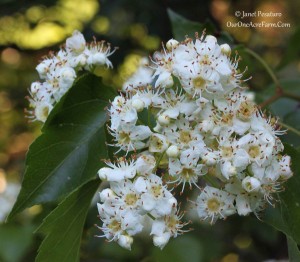
The flowers of Washington Hawthorn are visited by many pollinators. Birds love the berries, and you can cook with them.
There are many species of hawthorn native to North America, all with excellent wildlife value. So take your pick, but consider these 2 words of advice: 1. Grow one that is appropriate for your particular hardiness zone, and 2. Avoid planting non-native hawthorns, because some are invasive, and none support native wildlife as well as native hawthorns.We have a Washington Hawthorn that is alive with pollinators when in bloom, alive with birds when berries are ripe.
Wildlife value
- Many birds take berries in winter. Ruffed grouse, cedar waxwings, and fox sparrows are particularly fond of them.
- Thorns provide good protection for nesting birds.
- Flowers feed a multitude of pollinating insects.
Edible berries
- Mildly sweet and can used to make jellies and jams.
- Can also be used to make hawthorn berry extract.
Other notes
- Susceptible to rusts and blights, eastern red cedar is host to one of the destructive rusts and should not be planted near it. (We planted a Washington hawthorn over 15 yrs ago and have had no problems with pests.)
- Can be used to create an impenetrable, thorny hedgerow.
6. Red Mulberry, Morus rubra
Oh, how I would love to have a red mulberry in our yard. It’s native, and the sweet berries are prized by countless birds and mammals, and by my own palate. They are truly delicious.
Wildlife value
- Larval host plant for mourning cloak butterfly.
- Berries are taken by over 40 species of bird, and preferred by many of them. Various woodpeckers, thrushes, waxwings, tanagers, sparrows, orioles, jays, and more, all love these berries.
Edible berries
- Sweet and delicious
- Can be eaten raw, by the handful!
Other notes
- The tree might fruit heavily by the time it’s 10 years old
- Prolific fruiting can leave a mess on the ground if you don’t harvest any berries. Don’t plant it where that will bother you.
7. Serviceberry, Amelanchier species
There are many serviceberries native to North America, and they are way under utilized in the wildlife and edible garden. Some grow as shrubs and some grow as small trees. We have 3 serviceberry trees in our yard, and they are my favorites. In spring, serviceberry is a lacy veil on the landscape, with its whispy branching habit and delicate white or pale pink flowers. And in fall, the leaves turn bright yellow, orange, or red.
Wildlife value
- Because it blooms early, it is especially useful for pollinators when there is little else available. Mine are always buzzing with pollinating insects, when blooming.
- Larval host plant for red-spotted purple butterfly.
- Thrushes, orioles, tanagers, woodpeckers, grouse, American redstart, and cardinals, are among the approximately 30 bird species known to enjoy serviceberries.
Edible berries
- Sweet enough to be eaten raw.
- May be too sweet for jellies and jams, but are said to be excellent when dried.
Other notes
- In some areas (such as my area of Massachusetts), serviceberry fruits are damaged by rust, leaving few good berries.
- In other areas (perhaps the midwest) it does extremely well, providing abundant fruit for many wildlife species, and for people.
Large trees
These trees all grow taller than 50 feet, and take longer to fruit. Plant them for their wildlife value, or to benefit the next generation. If you already have mature trees and need to remove some, use this as a guide for which trees to retain.
8. American Basswood, Tilia americana
The basswood, also called Linden, is not often considered for its wildlife value, possibly because it does not have conspicuous fruits favored by birds. But my own philosophy is that it’s best to provide for a diversity of wildlife, and this tree appeals to a different group than the berry eating birds.
Wildlife value
- Favored by sapsuckers for drilling sap wells. These wells provide food (sap) not only for the sapsuckers, but for ruby-throated hummingbirds, which drink from these wells in early spring, when flowers are scarce.
- Flowers are highly attractive to bees due to prolific nectar production.
- Larval plant for red-spotted purple, mourning cloak and eastern tiger swallowtail butterflies.
- Seeds are eaten by many small mammals, such as squirrels, chipmunks, mice, and voles.
- As the tree declines, cavities form that attract many cavity nesting wildlife species, such as wood ducks.
Edible parts
- Young leaves can be eaten as a salad green. They are best in spring, just after the leaves unfurl.
- Sap can be boiled to make syrup
9. American Beech, Fagus grandifolia
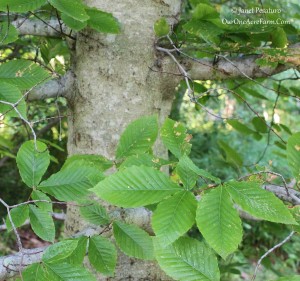
American beech has smooth bark even when mature. When fruiting, this tree is alive with hungry mammals and birds.
This is an excellent tree for both humans and wildlife. Its unusually smooth bark is beautiful and provides a nice contrast to the rough bark of many other trees.
Wildlife value
- Many kinds of animals, from birds to mammals, relish the small nuts.
- Turkeys, wood ducks, ruffed grouse, woodpeckers, nuthatches, jays, and crows all love them.
Edible parts
- Some people love the nuts, but preparing them requires a lot of work. They must be hulled, husked, and (at least) slightly cooked. I don’t feel it’s worth the time.
- Young leaves in spring, just after they unfurl, are sweet and edible, though not quite as tender as lettuces.
Other notes
- Beech is susceptible to beech bark disease, which has a fungal and insect component. Some trees may be resistant, but others die within 5 years.
- If the tree is not stressed, it can live for many years with a sub-lethal infection.
10. Birches, Betula species
There are many birches native to North America, but paper birch (Betula papyrifera) or black birch (Betula lenta) are best for birch syrup production (see below). Paper birch is stunning in the landscape, but does best in cold climates. So if paper birch isn’t a good choice for your yard, consider black birch. It lacks the striking white bark of its cousin, but it’s longer lived and more tolerant of warmer climes.
Wildlife value
- Seeds favored by many small birds, such as goldfinches and siskins.
- Grouse feed on the buds.
- Host to over 400 species of butterfly and moth, including eastern tiger swallowtail, and some of our giant silk moths, such as the luna, cecropia, and polyphemus moths.
Edible parts
- Sap of paper birch and black birch can be tapped to make a delicious syrup with many uses. See my recipe for Birch Syrup Ice Cream.
- Birch syrup is popular in Canada and Russia, and becoming more popular in the US.
- You can make wintergreen extract from twigs of yellow birch or black birch
11. Black Walnut, Juglans nigra
If you are interested in edible wild nuts, you should taste the black walnut before planting a tree or retaining it in your forestry plan. Most people either love ’em or hate ’em.
Wildlife value
- Squirrels of all kinds love black walnuts, and are well able to open their shells with their large incisors
- Many birds species appreciate the nuts, but cannot open the thick shells. They can, however, pick out left over fragments of nutmeat which have been opened by squirrels.
- Popular roosting tree for eastern screech owl
- Deer browse the buds, and rabbits and mice nibble at the twigs.
Edible parts
- The nuts are edible, but but some people find them very bitter.
- Variation in perception of bitterness in the black walnut may be due to genetic differences. See explanation on my black walnut ice cream recipe.
- It is said that the longer a fully ripened nut stays in the husk, the more intense the bitterness, though I have not put this to the test.
- Some people really love black walnuts!
Other notes
- Black walnut produces a compound called juglone, which inhibits the growth of some other plants, so plant it away from your vegetable garden, and don’t plant a lot of them.
- A number of plants are resistant to juglone, such as beech, birch, and maple.
- Juglone shouldn’t necessarily scare you away from black walnut. Certain other plants also produce compounds that inhibit the growth of other plants; this is not unique to black walnut.
12. Hickory, Carya species
There are many hickories along the roads and within the woods where I walk, and for some reason they’ve always fascinated me. I love the big thick winter buds, the interesting bark, and all the wildlife activity around them when the nuts are ripe in fall. Wildlife seem to like the nuts of all species, but only some species bear nuts that people can eat.
Wildlife value
- Small mammals of all kinds love the nuts.
- Many bird species and other animals that cannot open the shells, gobble up the fragments left behind by squirrels.
- Hickories are host to over 200 butterfly and moth species, including the pale tussock moth, American dagger moth, and several of our giant silk moths (Io, Polyphemus, and luna moths)
Edible parts
- Nuts of some species are sweet and edible.
- If you live within its range (southern US), your best bet is probably the pecan (Carya pecan), due to its large, sweet nut and thin, easy to crack shell. Other edible hickory nuts have thicker, hard to crack shells.
- Here in the northeast, the best for eating is probably the shagbark hickory (Carya ovata), though the pignut (Carya glabra) and mockernut (Carya tomentosa) are also edible.
- In the midwest, the large nuts of shellbark hickory (Carya laciniosa) provide excellent eating.
- You can also make hickory syrup from the bark and hulls.
13. Maple, Acer species
Many of the maples are beautiful trees with stunning fall foliage. Choose any native maple that grows well in your region. But if you want to make maple syrup and live within the range of the sugar maple, Acer saccharum, grow that one (see below). Do not plant the Norway maple, because it is already invasive in some areas, and may prove to be invasive elsewhere.
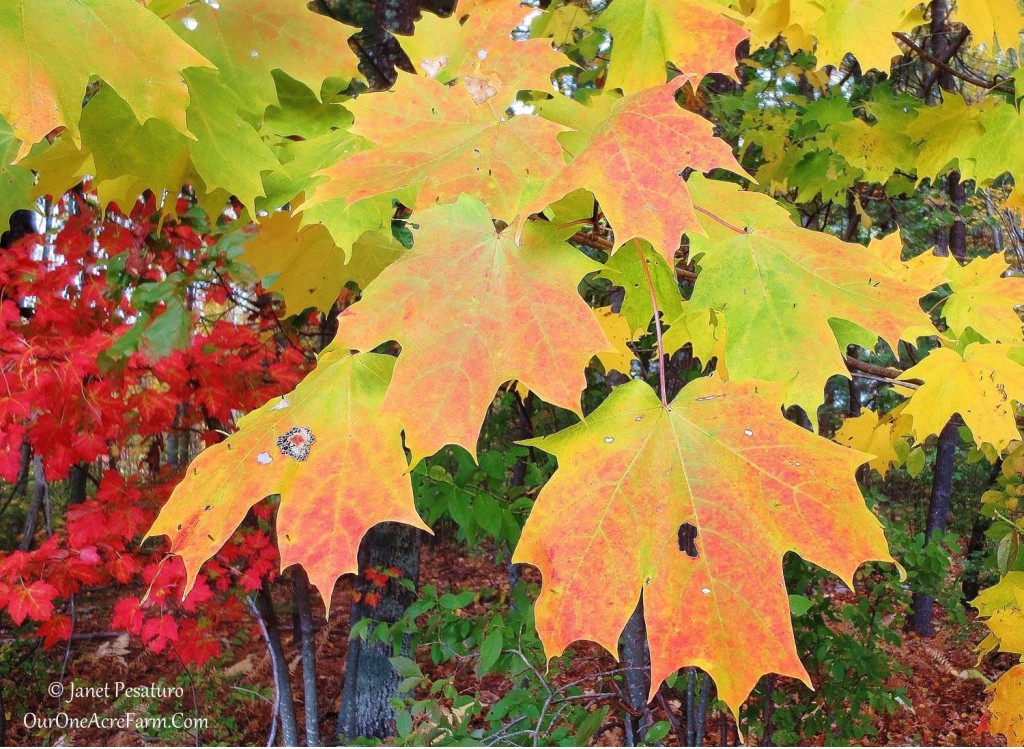
In addition to it’s wildlife value and its use in maple syrup production, sugar maple is spectacular in the autumn landscape.
Wildlife value
- Many birds and mammals enjoy the familiar winged seeds of maples.
- Maples are used by almost 300 species of butterflies and moths, including several of our giant silk moths, such as the Io, Imperial, and Cecropia moths.
Edible parts
- Sap can be boiled to make maple syrup, a beloved confection of the north. Sap of sugar maple contains a higher sugar concentration than any other maple. This means it takes less time and fuel to make maple syrup form the sugar maple. Other maples can be used, however.
- It can take 40-50 years for a sugar maple to achieve a size suitable for tapping using the traditional method.
- A new process of maple syrup production involves tapping saplings.
- Seeds removed from their winged cases, are edible. Those which are sweet are said to be edible in the raw. If they are bitter, they should be leached of their bitter compounds, just as acorns are leached.
- The young, early spring leaves of all maples are said to be edible, but I have tried only small amounts of red and sugar maples. They are mild, but not as tender as lettuces.
14. Oak Quercus species
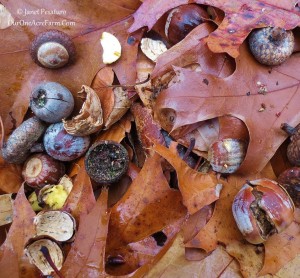
When acorns are produced in abundance, you can see evidence of animals feeding on them all over the forest floor.
There are over 50 species of oak native to North America. All are of excellent wildlife value, so choose one that does well in your area.
Wildlife value
- I needn’t mention the fact that squirrels love acorns, but it might surprise you that many other mammals do, too. Mice, porcupines, deer, and bear enjoy them.
- Acorns are a preferred food for jays, turkeys, grouse, and bobwhite. Many other birds eat them to some extent, including woodpeckers, thrashers, thrushes, titmice, and nuthatches.
- Oak is one of the top choices for native insects, supporting the larvae of over 500 species of butterfly and moth.
- Acorns are high in protein, carbohydrate, and fat, providing excellent nutrition for wildlife.
Edible parts
- People can eat acorns after the tannins have been leached out. The nut meats can be ground into a meal or flour, and used for breads and muffins.
- Acorns from species within the red oak family are higher in tannins and require more leaching than acorns of the white oak group.
Other notes
- In large amounts, leaves and acorns are toxic to cattle horse, sheep, and goats, due to high tannic acid. Once they develop a taste for oak, they may seek it out.
- Acorns are great food for pigs.
15. Spruce Picea species
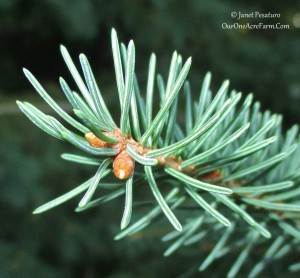
White spruce in late summer. Next spring, those brown buds will open into fresh, young leaves which are edible.
Any native spruce, fir, or pine is a great habitat element in the backyard, and the young leaves of all are edible. I chose to feature spruces here, because spruce needles are said to taste better, with a citrusy flavor.
Wildlife value
- Finches, grosbeaks, and crossbills are well equipped to harvest the seeds hidden within the spruce cones, and depend on them for food.
- Excellent winter cover for a great many mammals and birds, when deciduous trees are bare.
- Excellent cover for nesting birds in spring. We have two white spruces, are both have been used frequently by nesting birds in spring.
Edible parts
- Young spruce needles are edible when they emerge in spring, before they darken (look for the lighter green growing tips).
- Use spruce tips in recipes such as this one with pasta and wild mushrooms.
- Can be used to make spruce tip syrup or tea.
Sources
- Beech Bark Disease
- Top 10 Woody Plants in Conservation Gardening
- Mountain Ash
- American Basswood
- Maples
- Maple Syrup from Saplings
- Ladybird Johnson Native Plant Database
- All of the books in the Amazon ads above
What are your favorite trees for a wildlife friendly and edible backyard?
Shared on: Homestead Barn Hop, Natural Living Monday, Thank Goodness it’s Monday, Mostly Homemade Monday, Tuesdays with a Twist, Backyard Farming Connection, Wildcrafting Wednesday, Down Home Blog Hop, Green Thumb Thursday, HomeAcre Hop, From the Farm Blog Hop, Simply Natural Saturdays, Green Thumb Thursday











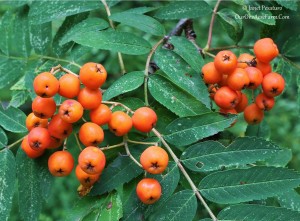

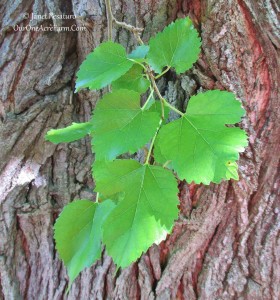
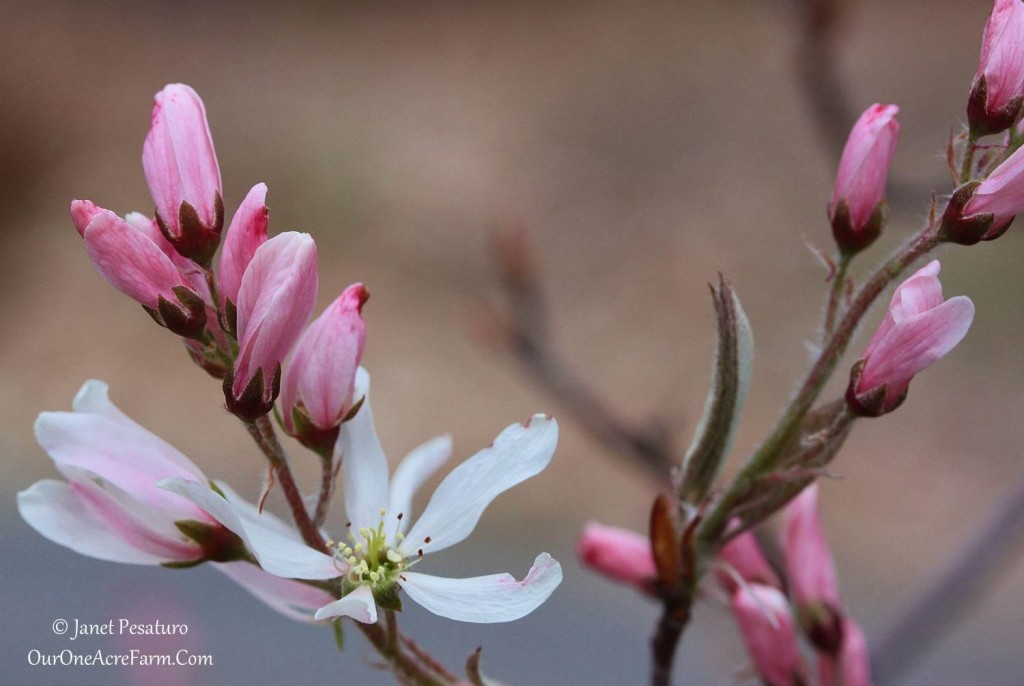
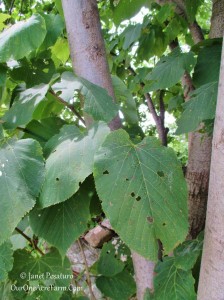
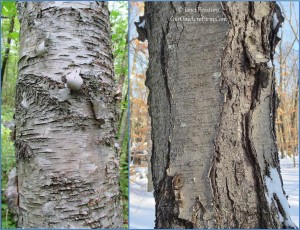
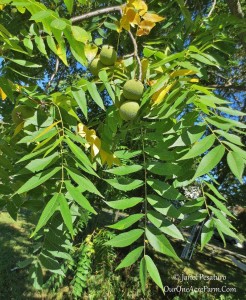
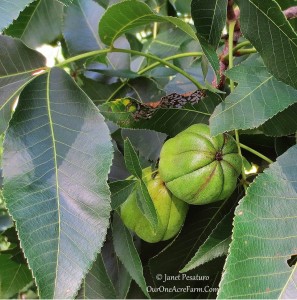
This is fascinating information! I had no idea that so many common trees have edible fruits! Up here in Canada we call service berries “saskatoons”, and I love them! They prefer drier, sandy soil, so I find them mostly on hills.
Interesting to hear about the “saskatoons”, and that they like dry, sandy soil. Some species of serviceberry (there are many) must like moister, richer soil, because they grow at pond edges. Ours are actually in a somewhat moist spot, and they are thriving. Thanks for stopping by!
I am so glad you talked about the importance of native plants! I have worked with many environmental groups removing non-native species and it is amazing the affects non-native plants can have. I have seen non-native trees, grasses and shrubs dry up an entire creek. Most places have native plant societies or extensions from neighboring ag colleges who will come out to assess your current landscape and make suggestions for you!
Thanks, Kristina. I am a volunteer on our town’s conservation commission, and it breaks my heart that we have to even consider treating invasive plants with herbicides. It’s so important just to get people to stop planting invasives and start planting native plants. At least in their yards, they can maintain native plants which, in wild areas around here, so often get smothered out by invasives.
Janet this article is just packed with information. Very well done post. I remember my mother hating those small black cherry tree berries. we would get them smooshed on the bottom of our sneakers and track the juice into the house. I didn’t know that you could eat them because, of course, all mom did was complain about them. We live in a heavily wooded area so this information is great to have available. I will pin it too. thanks!
Thanks, Janet! Yeah, trees with prolific berry or nut production can be a nuisance in the wrong location. We don’t usually mind them because it adds to the “rustic” (OK, messy!) appeal of the place 😉
I had a similar goal on my property too. I am not nearly as knowledgeable as you are when it comes to trees. This is a wonderful article. Thank you!
Thank you, Cynthia!
We love trees and have had to stop planting them as we have PLENTY now on our little 1/4 acre! We would LOVE to have a little land to expand our trees. 🙂
Oh, yeah, it’s hard to think about planting trees on a 1/4 acre. I’ll be doing future posts on shrubs and herbaceous plants, and maybe those will be more useful to you. Thanks for stopping by!
What a great list of trees! I’m sharing this on my FB page. We are lucky to have 3 of the trees at Happy Acres, including a giant Red Mulberry tree. It brings in so many birds when the berries are ripe. We also have 2 mature Black Cherry trees and a large maple, plus our neighbor has several Black Walnuts. Unfortunately, previous owners also planted many non-native trees like Kousa Dogwood and trashy ones like Bradford pears. We will be looking to replace those with native ones in due time.
Thanks so much, Dave! I am really jealous of that red mulberry I LOVE the berries and wild animals agree. I’m gonna try to make room for one next spring!
‘Love this post! I am featuring it today at Tuesdays with a Twist! -Marci @ Stone Cottage Adventures
Why, thank you, Marci!!
Wow! Great article! That’s quite a collection, I love learning about the uses of plants! Thanks for sharing on Wildcrafting Wednesday! 🙂
Thanks for the compliment, kathy!!
Pingback: 146th Wildcrafting Wednesday « Mind Body and Sole
Pingback: Wildcrafting Wednesday 8-27-14 - Herban Momma
Great post. So much great information! Congrats on being chosen as a featured post on this week’s Wildcrafting Wednesdays! I hope you’ll join us again and share more of your awesome posts.
Thanks, Kristin, I’ll definitely be back!
Pingback: The HomeAcre Hop #85
Love this! So informative! I love the amount of detail you include. Great post!
Thanks for joining up with Green Thumb Thursday! I hope you’ll link up again this week!
~L
Thanks for stopping by, Lisa!
Love this post! I was walking my property with my ipad looking at trees and comparing them to your pictures! Now I know a whole lot more about my woods!
Thanks for sharing with us at Green Thumb Thursday! This weeks hop is still open…..I hope you’ll stop by and link up again!
~Lisa M
Great post, Janet – thanks!
We moved to our little corner pf Paradise, in the foothills of the Appalachians in rural Middle Tennessee, not quite three years ago. we have about 16.5 acres total, about 3/4 of which is wooded, and we already have many of the trees on your list; including mature black walnuts, black cherries, American persimmons, red mulberries, shagbark and shellbark hickories, several varieties of maples and birches, pines and spruces, elderberries, and doubtless more.
I had no idea how many of these are host to my beloved luna moths, not to mention all the other native pollinator species, so thanks for that information. Like you, I am still seeking native hackberry and American mountain ash trees, among many others.
Last month I finally planted three Dunstan chestnut trees, which are not only also fabulous wildlife trees, but prior to the chestnut blight of the early 1900s, the American chestnut was the number one mast tree in the Eastern U.S., and was the basis of a large scale economy in much of the South and the Appalachian region. The Dunstan chestnut is a hybrid of a single massive blight-resistant American chestnut, crossed to the naturally resistant Chinese chestnut, then crossed back to the American chestnut multiple times over several generations, until it is now 7/8 American chestnut, with all the great qualities of the original – fast growing, excellent rot-resistant lumber, prolific production of highly nutritious nuts, great wildlife habitat and food, and more.
Next year I will probably plant at least a couple Colossal chestnuts, another blight-resistant American chestnut hybrid developed in my native California, as part of my ongoing effort to return our woods to something more resembling their original species makeup. Before the blight, fully one out of every four trees in the Eastern United States was a chestnut. Clearly this will be a lifelong ongoing project.
One thing in our favor is that our property is bordered on its eastern side by the Calfkiller River, which runs for 42 miles, so as our chestnut trees mature and start producing nuts, the squirrels, birds and other animals will assist in relocating the nuts up and down the river, many of the seedlings of which should become blight-resistant trees in their own right, thus helping to re-establish the American chestnut throughout at least our little corner of its former range.
While I grant that the American chestnut is a pretty massive tree to consider for a one-acre plot, you may wish to consider the native chinkapin, which is a chestnut relative which was also nearly wiped out by the chestnut blight. The chinkapin (not to be confused with the chinkapin oak) is a large bush to a small tree, bears a prolific crop of much smaller chestnut-like nuts, which are beloved by a large variety of wildlife including squirrels, deer, turkey, grouse, and even people.
I am also into foraging and plant medicines, and am actually going on an edible plant walk tomorrow near Crossville, TN, so now that I have found your blog I will look forward to your future posts.
Best of luck with your place!
Hi Cori, that does indeed sound like paradise! Great points on the chestnuts. Maybe I should have included a hybrid chestnut, but I was trying to go all native on this. Also, the American Chestnut Foundation has bred a tree that is 97-99% American, I think, so I’d rather wait for that to become more widely available before encouraging the planting of hybrids. I think they are selling them to conservation organizations now, but not to individuals.
I’m planning a similar post on shrubs for next spring, and might include chinquapin pumila. However, they are somewhat susceptible to chestnut blight, as well, and I am not sure how well they fruit these days overall. Sounds like you have found some excellent producers, though, so maybe it is worth including. They are said to be hardy to zone 5 or 6, yet more of a southeastern dweller, and not native to my state of MA. That said, I recently found one growing along a side road – maybe a person planted it there. I’ll have to return to see if it’s got any nuts.
Anyway, thanks for stopping by and sharing your thoughts and all of that info!
Pingback: 15 Trees For A Wildlife-Friendly & Edible Landscape — Homestead and Survival
pacific northwest elderberry trees are very valuable for immune boosting tonic and tasty jam and jelly. Oregon grape also is a useful medcinal and nutritional herbal bush/shrub
Yes, Wendy, those are excellent for both people and wildlife. They didn’t fit in this post, which is specifically on trees, because one is a shrub and the other a vine. They will be included in future posts 😉
Janet, we have hackberry trees down here in Texas, but I don’t know if they are the type you are looking for, but they produce small reddish orange berries that are edible and raccoons and birds of all kinds enjoy them and they are sweet to eat raw too.
Sounds like the same one, Ronnie. They are reputedly loved by wildlife, but I’ve never seen one. I think my area is at the limit of its range, which would explain why I haven’t seen one. They are probably uncommon here.
Pingback: 10 Shrubs for a Wildlife-Friendly, Edible Landscape - One Acre Farm
Hi Janet – nice posting, with some good suggestions.
Folks interested in this topic might also like to read this blog posting: nativeplantwildlifegarden (dot) com/grow-your-own-edible-native-plants-for-new-england/
and this one: www (dot) ecolandscaping.org/09/ecological-landscaping-101/edible-and-landscape-worthy-native-plants-of-new-england/
Last but not least – here’s a link to some info I have compiled on the Edible Native Plant Species of the Northeast US: www (dot) ecolandscaping (dot) org/wp-content/uploads/2013/03/Edible-Native-Plants-of-Mass.-Northeast-U.S.-and-E.-Canada-March-18-2013.pdf
Thanks, Russ!
Great info. i was happy to see that i have 3 trees…serviceberry, washington Hawthorn and three maples… Ive aLways looked for trees that have flowers and berries for the wildlife.
That’s great, Penny. You have three that are particularly beautiful, too!
Pingback: 12 Native Plants for Food and Medicine - One Acre Farm
Pingback: Permaculture Principles for Practical Gardeners and Farmers - One Acre Farm
Pingback: A Time to Keep June 2015 - Homestead Lady
Fantastic information! We are just starting out on our homestead and this info is very helpful. Now I just need to cross reference it with native trees of the Pacific northwest. Hopefully I can find info as good as this to work off of. Thanks so much great articles!
Glad you found it helpful. And good luck with your new endeavor – A homestead in the Pacific northwest sounds lovely!
Pingback: What is Permaculture? | Tenth Acre Farm
Greet posting. Very informative and good for the home garden. Best regards.
I’ve seen serviceberries growing in urban landscaping in both Louisville, KY and Gettysburg, PA. In both locations they produced vast quantities of berries, with only one out of 11 trees exhibiting diseased berries. I believe the species to have been either canadensis or arborea, or a cross with grandiflora. Either way, the berries were delicious, until the disciplinarian told me to stop harvesting because he didn’t want me to get poisoned.
So, in short, some serviceberries do indeed produce very well in certain climates. Namely, my own.
I’ve seen serviceberries growing in urban landscaping in both Louisville, KY and Gettysburg, PA. In both locations they produced vast quantities of berries, with only one out of 11 trees exhibiting diseased berries. I believe the species to have been either canadensis or arborea, or a cross with grandiflora. Either way, the berries were delicious, until the disciplinarian at my school (where they grow) told me to stop harvesting because he didn’t want me to get poisoned.
So, in short, some serviceberries do indeed produce very well in certain climates. Namely, my own.
Pingback: The Backyard Farming Connection Hop #96 – Homesteadrr
Hi, Thank you for this.
I learned hackberries this year.
There were plans to renovate a cemetery near me and one of my favorite trees was to be taken down. It was a hackberry that had dropped a large branch. It took me a while to ID the tree.
Now I see hackberries fairly often as I walk out of the way places here in Salem MA. And in my tiny 4,500 sq. ft. lot in Salem, I have about 200 sq ft behind the garage that I don’t touch, there I found two small 7′ hackberries growing naturally.
I purchased small weekend getaway house in Galax Virginia with land.I am big fan of wildlife and birds.I would love to plant fast growing berry producing trees for shelter and food on my property but having difficulty finding the landscapers to this scale landscaping.Any suggestions?
Re-check the zones for Persimmons. I ordered four American Persimmons after tasting them up at UVM. They should be fine where you are. I also planted six paw paw trees last year, and they came back just fine. They are very slow growing, but better to start now, rather than put it off; I won’t get fruit for at least five to seven years, but after tasting one, I had to get some. I’d thought about it years ago; I’m kicking myself that I didn’t plant some then. I love that both of these will be very late fall harvests, well after the vegetables and other fruits will be done.
Along with those, I’ll be getting a medlar and a quince tree to round out my food forest. They are also late harvests. I, too, have an acre, and I just removed @120 x 15 feet of sod along the sidewalk. I planted a hedge of Regent serviceberries, and many, many edible plants and trees behind. I planted some rougher looking plants out back: four hazelnuts, two goumi, and two elderberries. I think I’ve planted every edible fruit and perennial vegetable that I can find, but I’m always on the lookout for ones I haven’t heard of. I don’t want anything that is not relatively well-behaved, though. As much as I love raspberries, I won’t plant them because of how invasive they seem to be…that and the thorns…I will buy those or go to a U pick place!
Sorry…I forgot to mention that I live in zone 4-5a Vermont.